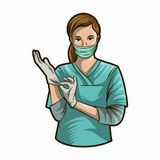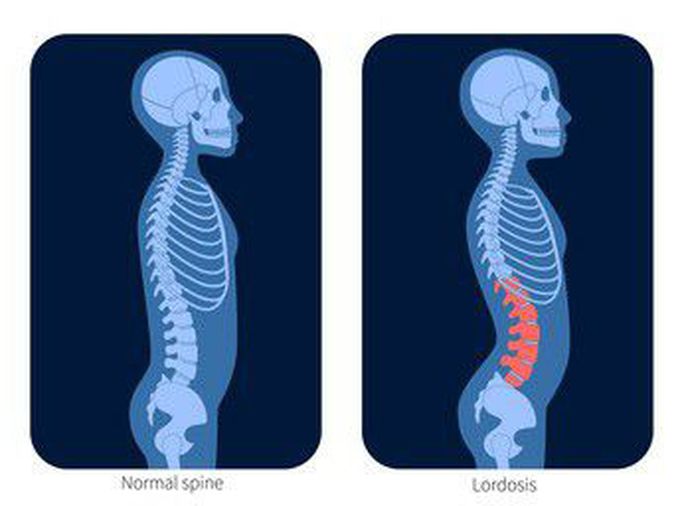


LORDOSIS
Lordosis refers to an exaggerated inward curve of the spine. Some people call the condition “swayback.” Lordosis most often occurs in the lower back, in which case it is called lumbar lordosis. If it occurs in the neck, the medical name for it is cervical lordosis. The spine can also curve outward, in a hump shape, and this is called kyphosis. It typically affects the middle or upper back, rather than the lower back or neck. Sometimes, having another type of spinal curve causes the body to develop lordosis, to compensate for the existing imbalance. Symptoms The defining characteristic of lordosis is an exaggerated inward curve of the spine. Depending on the location, lordosis can cause the buttocks and stomach area to stick out. A person with lordosis may find it difficult to lie flat on the floor, due to the curve in their back. In many cases, lordosis alters a person’s appearance but causes no symptoms. However, severe lordosis may cause: back or neck pain pain that radiates into the legs and feet, which is called sciatica tingling or numbness Rarely, lordosis may cause a person to lose control of their bladder or bowels or experience sudden, severe leg pain or weakness. If this happens, seek medical attention immediately. Causes and risk factors Doctors do not always know why lordosis develops, but there are certain causes and risk factors. These can help a doctor classify lordosis, as follows: Traumatic lordosis: This is caused by an injury to the spine, such as a fracture. Osteoporosis, which weakens the bones, may increase the risk of these fractures. Congenital lordosis: This can stem from an inherited condition such as achondroplasia, which affects cartilage growth. It can occur due to a problem with the development of the spine during childhood. Postural lordosis: This is caused by uneven posture. Having overweight or weakness in the abdominal muscles can increase the risk, as both factors strain the lower back. Neuromuscular lordosis: Several neuromuscular conditions can cause lordosis, including muscular dystrophy and cerebral palsy. Postsurgical lordosis: This results from back surgery that makes the spine less stable, such as a laminectomy or selective dorsal rhizotomy. Secondary lordosis: This results from having another condition — possibly another type of spinal curve, such as kyphosis or scoliosis, or a condition that affects the hip joints. Obesity: Carrying excess weight can cause the bones and muscles to “lean backward” to improve balance. Osteoporosis: Age and other factors can cause bones to weaken and become brittle, which may lead to curvature of the spine. Spondylolisthesis: This causes one vertebra to slip forward, over another, and it can cause lordosis, usually in the lower back. Diagnosis A doctor can usually identify lordosis with a physical examination. They may also use an X-ray, MRI, or CT scan to confirm the diagnosis. A scan can indicate the extent of the curve in the spine. If the person has symptoms of an injury or a medical condition that can cause lordosis, the doctor may perform additional tests to diagnose the underlying cause. Treatments If the curve in the spine is mildly exaggerated, a person may not require treatment. Often, if there is no pain and the curve does become more pronounced, a doctor does not need to intervene. When lordosis does require treatment, the right approach depends on the cause of the curvature. For example, postural lordosis caused by muscle weakness or overweight may improve with physical therapy and weight management. If a child has lordosis, a doctor may recommend a back brace to prevent the curve from progressing as the child grows. If lordosis causes pain, nonsteroidal anti-inflammatory drugs, or NSAIDs, such as ibuprofen (Advil), may help. A person with severe lordosis may require surgery, during which a surgeon attaches metal rods to the bones in the spine, which permanently fuse into a straighter position. Exercises A healthcare professional can help identify exercises that are safe and effective for people with lordosis. A doctor may recommend a physical therapist or trainer who specializes in these types of conditions. The American Council on Exercise (ACE) identify several that can benefit people with abnormal spinal curvature. ACE recommend the following exercises for people with lordosis. Hip flexor stretches To perform a hip flexor stretch, start from a kneeling position on a soft surface, such as a yoga mat. Place the right foot in front of the body, so that the knee bends at a 90-degree angle, with the right knee directly over the right foot. Pull the shoulders down and back, without arching the back, and keep the pelvis and spine stable. Lean forward into the right hip while keeping the left knee on the ground — and with the pelvis facing forward. Hold the stretch for 30–45 seconds at a time, and repeat 2–5 times for each hip. If it feels comfortable, lean further into the hip to deepen the stretch. Cat-Cow Pose To perform the Cat-Cow yoga pose, start on the hands and knees on the floor or a yoga mat. Place the knees hip-width apart, with the toes flexed. Place the hands directly below the shoulders, facing forward, and shoulder-width apart. Use the abdominal muscles to move the spine into a neutral, straight position. Exhale and slowly arch the spine toward the ceiling, allowing the head to drop down, and hold the position for 10–15 seconds. Inhale and relax the spine, allowing the stomach to fall toward the floor, and hold the position for 10–15 seconds. Return the spine to a neutral position. Supine hollowing According to ACE, to perform supine hollowing, a person should: Lay on the back with the knees bent and the feet flat on the floor, about 1 inch from the buttocks. Extend the arms to the sides at shoulder level. Breathe deeply and allow the shoulders to relax. Pull the shoulders down and back, without arching the back, and hold this position during the exercise. Perform a gentle Kegel exercise — contracting the pelvic floor as if trying to stop urination. Draw the belly button toward the lower back without moving the hips or ribcage. Perform the Kegel while pulling the belly inward, and repeat this while breathing normally. A person can add the following steps as they get better at this exercise: Lift one leg about 3–6 inches off the ground without moving the torso. Lift the toes of one foot off the floor, and slide the foot 3–6 inches away from the buttocks without moving the torso. If any exercise causes pain or worsens symptoms, stop immediately.

